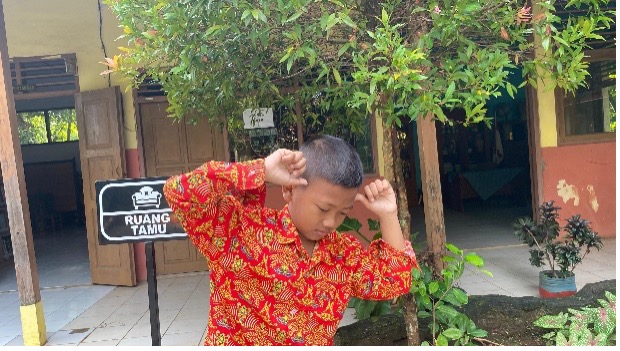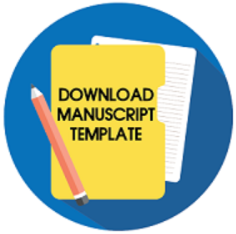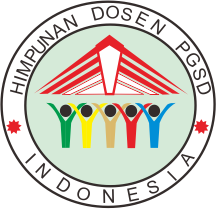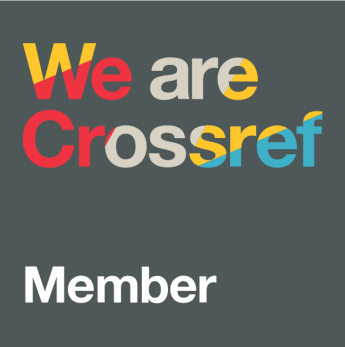The Development of Kinesthetic Skills in the Lembu Dance Extracurricular Program at Elementary School

Downloads
Downloads
Ahyar, H., Maret, U. S., Andriani, H., Sukmana, D. J., Mada, U. G., Hardani, S.Pd., M. S., Auliya, G. C. B., Andriani, H. M. S., Fardani, R. A., Ustiawaty, J., Utami, E. F., Sukmana, D. J., & Istiqomah, R. R. (2020). Qualitative & Quantitative Research Methods Book. CV. Pustaka Ilmu.
Amrullah, K., & Suwarjo, S. (2018). The effectiveness of the cooperative problem-based learning in improving the elementary school students’ critical thinking skills and interpersonal intelligence. Jurnal Prima Edukasia, 6(1), 66–77. https://doi.org/10.21831/Jpe.V6i1.11253
Anggia, F., & Marzam, M. (2024). Implementation of the independent curriculum in the dance arts subject of class VIII SMPN 5 Padang. Mysterious: Publikasi Ilmu Seni dan Desain Komunikasi Visual., 1(2), 145–155. https://doi.org/10.62383/Misterius.V1i2.142
Arni, Y., Utami, W. W., Khoirunnisak, L., & Amelia, F. (2024). The effect of visual, auditory, kinestic learning styles on student learning outcomes in science subjects. Journal of Education and Teaching Learning, 6(1), 119–129. https://doi.org/10.51178/Jetl.V6i1.1794
Christian, I. V., & Prasida, A. S. (2018). Developing board game as learning media about waste sorting for fourth grade students of elementary school. Jurnal Prima Edukasia, 6(1), 78–88. https://doi.org/10.21831/jpe.v6i1.17148
Creswell, J., & Guetterman, T. (2018). Educational Research: Planning, Conducting, and Evaluating Quantitative and Qualitative Research, 6th Edition. Upper Saddle River.
Damayanti, R., & Mawardi, M. (2018). Developing of MITRA learning model of problem solving-based to solve mathematical problems in elementary school. Jurnal Prima Edukasia, 6(1), 1–10. https://doi.org/10.21831/jpe.v6i1.17238
Dang, T., & Hong, B. V. (2024). Enhancing students’ motivation for mathematics through a cooperative learning approach. Vinh University Journal of Science, 53(Special Issue 2), 312–320. https://doi.org/10.56824/vujs.2024.htkhgd248
Delia, A. S., & Yeni, I. (2020). Creative dance design for gross motor development of early childhood children. Jurnal Pendidikan Tambusai, 4(2), 1071–1079. https://doi.org/10.31004/jptam.V4i2.570
Dewi, R. A. K., & Rukmini, P. (2019). The effect of thematic learning by using a scientific approach to increase the multiple intelligence of students. Jurnal Prima Edukasia, 7(1), 40–46. https://doi.org/10.21831/jpe.v7i1.24326
Diva, N. Z., & Marzam, M. (2024). Improving student learning outcomes in arts and culture learning (Dance) at SMPN 2 Sungai Geringging through the talking stick method. Misterius: Publikasi Ilmu Seni dan Desain Komunikasi Visual., 1(2), 121–132. https://doi.org/10.62383/misterius.v1i2.140
Djafar, N., & Djafri, N. (2024). Cultivation of cultural literacy and creativity through traditional dance learning at SMP 1 Kabila Bone as a form of object for the advancement of regional culture in the Tomini Bay Area. Prosiding Seminar Nasional Ilmu Pendidikan, 1(2), 08–22. https://doi.org/10.62951/prosemnasipi.v1i2.27
Farindhani, D. A., & Wangid, M. N. (2019). Scientific-based pictorial storybook with project-based learning method for improving the critical thinking skills of elementary school students. Jurnal Prima Edukasia, 7(1), 94–105. https://doi.org/10.21831/jpe.v7i1.8807
Fitriana, M. D. N. (2017). The influence of self-confidence and parental support on motivation to learn traditional dance. Psikoborneo: Jurnal Ilmiah Psikologi, 5(4), 570–576. https://doi.org/10.30872/psikoborneo.v5i4.4476
Freedman, C. (2022). Lessons learned: Kinesthetic learning and engaging students with adhd (in the time of Covid). Master of Science in Education Master’s Theses, May, 2–4. https://scholar.dominican.edu/education-masters-theses/46
Hardi, H., Wahyudi, W., Suyitno, H., Kartono, K., & Sukestiyarno, Y. L. (2022). The mathematic connection ability of pre-service teacher during online learning according to their learning style. Journal of Technology And Science Education, 12(1), 230–243. https://doi.org/10.3926/jotse.1198
Hasibuan, M. S., Nugroho, L. E., & Santosa, P. I. (2019). model detecting learning styles with artificial neural network. Journal of Technology and Science Education, 9(1), 85–95. https://doi.org/10.3926/Jotse.540
Hermanto, H., & Pamungkas, B. (2023). School and parents collaboration in home learning service for students with sensory impairments. Jurnal Prima Edukasia, 11(1), 9–15. https://doi.org/10.21831/Jpe.V11i1.51614
I Ketut, M., Mardana, I. P. R. A., & Astini, I. G. A. P. (2024). The implementation of the STAD-type cooperative model to improve students' ability in creating simple dances identified as having several problems: students' skills, interests, and talents, and types of learning models by grouping. Semantik: Jurnalriset Ilmu Pendidikan, Bahasa dan Budaya, 2(1). http://dx.doi.org/10.33578/pjr.v5i4.8441
Juwita, M., Setiawati, R., & Sudiasa, I. B. K. (2020). Physical exercise as a stimulus to improve children's dance movement ability in extracurricular activities at SDN Dukuh 09 Pagi, East Jakarta. Jurnal Pendidikan Tari, 1(01), 43–53. https://doi.org/10.21009/Jpt.114
Kakar, A. S., Naha, N., Mansor, A., Saufi, R. A., & Singh, H. (2019). Work-life balance practices and turnover intention: The mediating role of person-organization fit. International Journal of Advanced and Applied Sciences Person-Organization Fit. 6(9), 76–84. https://doi.org/10.21833/ijaas.2019.09.012
Khoo, N. A., Jamaluddin, N. Y., Osman, S., & Buchori, A. (2024). Exploring the interaction between learning styles and mathematics anxiety among secondary school students: A correlational study in Southern Malaysia. Journal of Technology and Science Education, 14(3), 683–700. https://doi.org/10.3926/Jotse.2224
Li, J., & Qi, Y. (2025). Arts education and its role in enhancing cognitive development: A quantitative study of critical thinking and creativity in higher education. Cognitive Development, 74, 101544. https://doi.org/https://doi.org/10.1016/J.Cogdev.2025.101544
Lluch-Molins, L., Balbontin-Escorza, F. Y., & Sullivan-Campillay, N. (2022). Enhancing cooperative learning and student motivation with gamification strategies: A case study in industrial engineering. Journal of Technology and Science Education, 12(3), 611–627. https://doi.org/10.3926/Jotse.1693
Lokoviti, M., & Pitsi, A. (2025). The role of contemporary dance in early school-age motor development. International Journal of Research-Granthaalayah, 13(3), 218–227. https://doi.org/10.29121/Granthaalayah.V13.I3.2025
Magulod, G. C. (2019). Learning styles, study habits and academic performance of Filipino university students in applied science courses: Implications for instruction. Journal of Technology and Science Education, 9(2), 184–198. https://doi.org/10.3926/Jotse.504
Marsiano, E., Nerosti, N., & Astuti, F. (2019). Inhibiting factors in learning arts and culture (dance) at SMP Negeri 4 Padang. Jurnal Sendratasik, 8(4), 11. https://doi.org/10.24036/Jsu.V7i4.105103
Mudianingrum, T. P., Romadhon, R., & Iswahyudi, D. (2024). Strengthening local culture: Implementation of extracurricular activities through dance arts at SMP PGRI 2 Singosari Malang. Civis: Jurnal Ilmiah Ilmu Sosial dan Pendidikan, 13(2), 80–93 https://doi.org/10.26877/civis.v13i2.18781
Munir, S., & Zaheer, M. (2021). The role of extracurricular activities in increasing student engagement. Asian Association of Open Universities Journal, 16(3), 241–254. https://doi.org/10.1108/aaouj-08-2021-0080
Putri, A. F., & Widiyono, Y. (2022). Efforts to improve dancing skills in traditional dance materials using peer tutoring methods at SD Negeri Pangenrejo 1. Edunesia: Jurnal Ilmiah Pendidikan, 3(2), 177–189. https://doi.org/10.51276/edu.v3i2.239
Putri, D. A. P., & Usriyah, L. (2021). Development of students' kinesthetic intelligence through traditional dance extracurricular activities at Al-Islah Elementary School, Muncar District, Banyuwangi Regency. Educare: Journal of Primary Education, 1(1), 1–16. https://doi.org/10.35719/educare.v1i1.2
Ramadhani, M. I., & Ayriza, Y. (2019). The effectiveness of quantum teaching learning model on improving the critical thinking skills and the social science concept understanding of the elementary school students. Jurnal Prima Edukasia, 7(1), 47–57. https://doi.org/10.21831/jpe.v7i1.11291
Rosi, S., & Susmiarti, S. (2023). Holistic approach in learning dance arts and culture in class XI IPS 1 of State Senior High School 1 Ulakan Tapakis, Padang Pariaman Regency. Student Scientific Creativity Journal, 1(6). https://doi.org/10.55606/sscj-amik.v1i6.2317
Sabahiyah, S., Wahyuni, S., & Hasanah, N. (2023). Dance arts training to develop students' creativity in elementary schools. Swarna: Jurnal Pengabdian Kepada Masyarakat, 2(7), 763–770. https://doi.org/10.55681/Swarna.V2i7.752
Scheff, H., Sprague, M., & Mcgreevy-Nichols, S. (2010). Exploring Dance Forms and Styles: A Guide to Concert, World, Social, and Historical Dance. Human Kinetics.
Shaidullina, A. R., Orekhovskaya, N. A., Panov, E. G., Svintsova, M. N., Petyukova, O. N., Zhuykova, N. S., & Grigoryeva, E. V. (2023). Learning styles in science education at university level: A systematic review. Eurasia Journal of Mathematics, Science and Technology Education, 19(7). https://doi.org/10.29333/Ejmste/13304
Sholihatunnisa, R. N., Muqodas, I., & Nikawanti, G. (2024). Creative dance learning to improve kinesthetic intelligence in early childhood. Jurnal Ilmiah Potensia, 9(2 Se-Articles), 150–159. https://doi.org/10.33369/Jip.9.2.150-159
Soomro, L., Ali, M., Sohu, F., Mustafa, M. G., & Ansari, M. I. (2023). Assessment of visual, auditory and kinesthetic style of learning among undergraduate nursing students of sindh. Pakistan Journal of Health Sciences, 30–33. https://doi.org/10.54393/Pjhs.V4i09.976
Suharja, S., Mustadi, A., & Oktari, V. (2024). Examining the brain-based learning model assisted by an open-ended approach to understanding mathematical concepts. Jurnal Prima Edukasia, 12(1), 19–29. https://doi.org/10.21831/jpe.v12i1.67303
Syarifah, S. (2019). Howard Gardner's concept of multiple intelligences. Sustainable: Jurnal Kajian Mutu Pendidikan, 2(2), 176–197. https://doi.org/10.32923/kjmp.v2i2.987
Tunggal, C. H. H. W. M., Widodo, W., & Malarsih, M. (2023). Lembu Tanon Dance packaging strategy based on local wisdom in Tanon Hamlet. Ideas: Jurnal Pendidikan, Sosial, dan Budaya, 9(3), 843. https://doi.org/10.32884/ideas.v9i3.1357
Turmuzi, M., Suharta, G. P., Astawa, W. P., & Suparta, N. (2024). Misconceptions of mathematics in higher education universities when learning with Google Classroom based on learning styles and gender differences. Journal of Technology and Science Education, 14(1), 200–223. https://doi.org/10.3926/jotse.2482
Tysha, A. S., & Handayaningrum, W. (2022). Character education through dance arts learning at SMAN 8 Malang. Jurnal Pendidikan Sendratasik, 9(1), 29–41. https://doi.org/10.26740/jps.v9n1.p29-41
Welong, S. S., Manampiring, A. E., & Posangi, J. (2020). The relationship between fatigue, learning motivation, and physical activity on academic achievement levels. Jurnal Biomedik:Jbm, 12(2), 125. https://doi.org/10.35790/jbm.12.2.2020.29516
Widianingsih, R., & Suklani. (2024). Extracurricular activities management in improving school quality. Rayah Al-Islam, 8(3), 710–718. https://doi.org/10.37274/rais.v8i3.1009
Winarti, A., Yuanita, L., & Nur, M. (2019). The effectiveness of multiple intelligences-based teaching strategy in enhancing the multiple intelligences and science process skills of junior high school students. Journal of Technology and Science Education, 9(2), 122–135. https://doi.org/10.3926/Jotse.404
Yuliasma, Nerosti, Asriati, A., & Desfiarni. (2023). Dance learning model using stories in elementary schools. International Journal of Elementary Education, 7(1), 19–26. https://doi.org/10.23887/Ijee.V7i1.57710
Copyright (c) 2025 Jurnal Prima Edukasia

This work is licensed under a Creative Commons Attribution-ShareAlike 4.0 International License.
The copyright of the received article shall be assigned to the journal as the publisher of the journal. The intended copyright includes the right to publish the article in various forms (including reprints). The journal maintains the publishing rights to the published articles.

Jurnal Prima Edukasia by http://journal.uny.ac.id/index.php/jpe/index is licensed under a Creative Commons Attribution-ShareAlike 4.0 International License.


























